| |
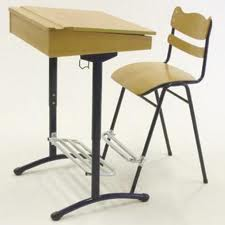

|
|
Masaka 2012
Guidance for young people who did not have the chance to complete their secondary studies.
Owner of the project: 'Communauté des Filles de la Résurrection' in Kigali
Responsable: Sister Marie Rose Kuramukobwa
Budget: Total cost : 3.697.050 RwFr
Local contribution: 1.206.250 RwFr
Requested amount: 2.490.800 RwFr i .e. € 3.325,00
I History
The priory of "Les Filles de la Résurrection" was founded in 1966 in the Republic of the Congo, by Mother Hadewych of the sacred grave. With this missionary work for the local population they wanted to alleviate their suffering, particularly for the poorest including the sick, the undernourished people, widows and the orphans. To meet this requirement they formed a community of nuns devoted to God and in the service of the poor.
The groups gradually grew and they were to expand to other areas of Central Africa. It is a fact that the sisters in 1982 for the first time opened their doors in Rwanda, in a central of Gatovu in the parish of Muhororo, diocese Nyundo, district Ngororero. This was continued in the same diocese but in a different parish Crète Congo nil.
During the genocide in 1994 everything was destroyed, and it was only in 1996, the sisters returned from Congo in order to resume their work. By the uncertainty they could not return to the same place but to a community Busasamana not far from Nyondo and the the spiritual and social activities were resumed.
On January the 1st 1997 6 sisters were murdered, and the monastery was closed until the end of the war. On October the 15th 2005 everything was restarted. Now there are 6 groups (monasteries): 3 in Nyundo, 1 in Kabgayi and 2 in Kigali. monasticism is fully autonomous since July 20, 2011, a decision made here in Belgium.
Activities of “Les Filles de la Résurrection”
The sisters are engaged in catechese in the parish, work in health centers especially in materniteit, education in primary and secondary classes, reception of widows, reception of young people who could not complete their secondary studies and learning them a profession such as :sewing, knitting, embroidering .... They also learn about hygiene, household, how to protect themselves against HIV, how to live and deepening in the African values. The sisters also help those who cannot read or write.
Introduction to the community of the sisters in Masaka
The monastery is located in Archdiocesan of Kigali, 30 km from the capital. It serves as home for the formation of novices and in addition, there are 2 centers, one for the literacy and one for the seewing training. All the young people come from poor families, 23 people in the class literacy and 50 in the seewing class. There is more demand but the number has been limited because of lack of material: machines, fabrics, tables, cupboards, ......
Without any training, these young people are left to poverty, crime, homelessness, prostitution, village exodus. In order to give them a better future the sisters find it necessary to deal with them, even though their capacity is limited.
II Objectives
in general: The project is meant to be a guidance of the young people, year after year, both boys' and girls'
specifically:
- initiate young people in a vocational training
- help for better social integration
- teach a spirit of creativity
III Duration of the project
The guidance will be 1 year.
IV Strategy of the project
For the realization of the project we count on the staff: sewing teachers and pedagogues. In addition, we want to increase awareness among the population of Masaka by involving them from the beginning to the end.
V Beneficiaries
Direct: The young people who hope that they can build a future with their training and experience in the lessons.
Indirect : the population of Masaka and the sisters (“Filles de la Résurrection”).
VI Local contribution
| Unit |
Amount |
Price per unit (RwFr) |
Total (RwFr) |
classrooms |
3 |
180.000 /month |
1.080.000 |
chalk |
5 boxes |
13.250 |
66.250 |
notebooks |
|
|
60.000 |
Total |
|
|
1.206.250 |
Requested contribution
| Unit |
Amount |
Price per unit (RwFr) |
Total (RwFr) |
sewing machines |
10 |
90.000 |
900.000 |
overlock machines |
1 |
150.000 |
150.000 |
fabrics |
6 |
41.700 |
250.200 |
scissors |
10 |
4.210 |
42.100 |
iron |
3 |
15.000 |
45.000 |
chair |
40 |
4.200 |
168.000 |
tables |
15 |
21.100 |
316.500 |
cupboards |
4 |
72.250 |
289.000 |
shelves |
4 |
60.000 |
240.000 |
transportation |
|
|
90.000 |
Total |
|
|
2.490.800 |
Top
Follow-up of the project
In a letter to the responsable of project in september 2012:
Dear mom Hilde!
These young girls have already learned a few basic stitches to embroider, how to work on the pedal machine, make skirts and small dresses for the babies. Today they learn how to take the measures to make dresses for the older girls and trousers for the boys ...
We also have bought them an embroider machine in order to decorate their clothing, but unfortunately we have no power, maybe next year because the government promised us.
Concerning the knitting process, we are not yet started because we need a sister who knows the machine so she can learn it to the young people. But she has already learned. Within a week I will send you the photos as well as the invoices of the rest of the money that we have saved to buy thread for knitting. Thank you for your patience.
Top
Images
More images: clic here.
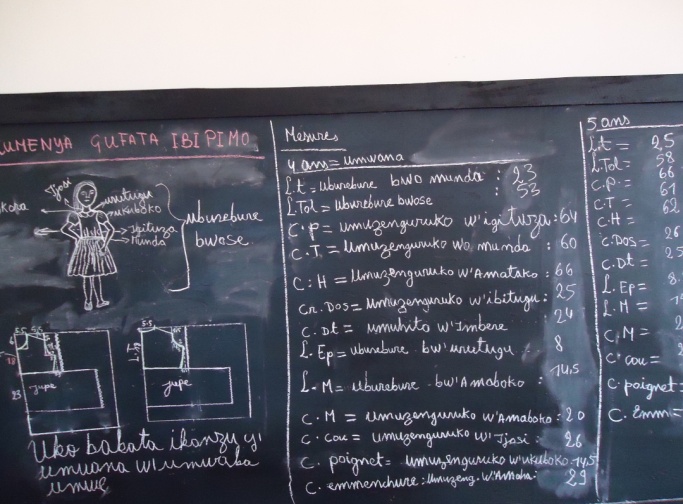 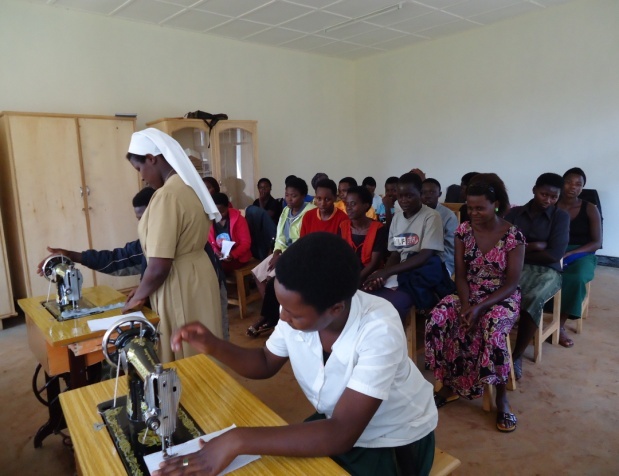
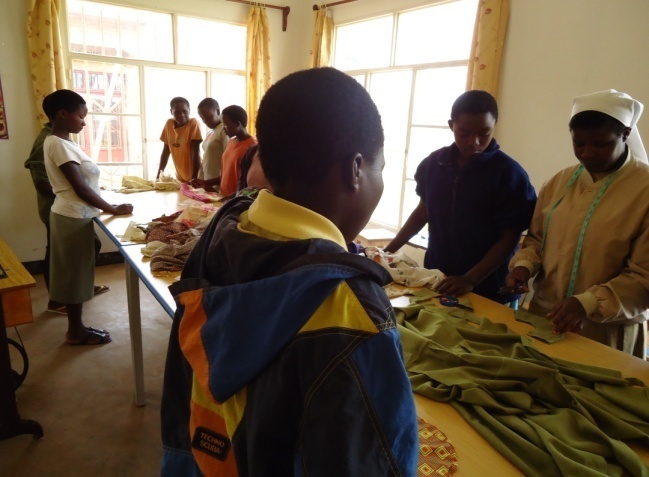 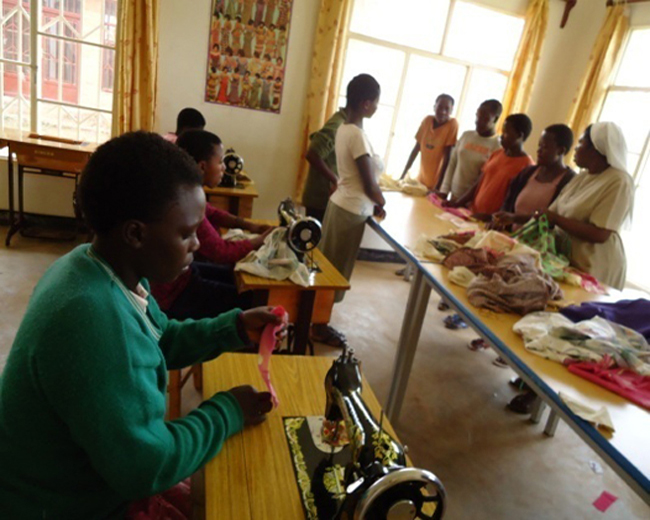
Top
Follow-up april 2013
Hi mama Hilde!
The project is progressing well; as I already informed you about group 1 had ended their education. Some students could get a sewing machine which means they have an income, others are still looking around for a machine. We keep on encouraging them.
The 2nd Group counts 27 girls. They are coming daily which means that is it not so evident to keep 2 groups busy: those who are responsible for selling the clothes (atelier) and those in education.
Related to the embroidery machine we are still waiting for electricity; these days we enlighten candles which are blocking some initiatives.
The knitting machines are functioning. Therefore we have the financial means to purchase tissues, thread, needles etc for the new students. It is a pity that knitting thread is so expensive comparing to the price of completed knitting products. The knitting thread is coming from Uganda which probably explains the high prices.
Dear Mama, our sincere regards and a big thank you to the whole team.
Zr M. Rose
Top
|
|






